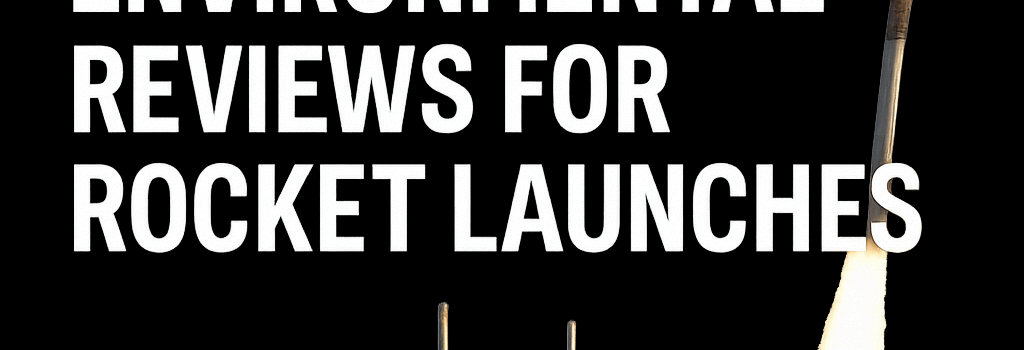Trump’s Efforts to Simplify Environmental Reviews for Rocket Launches

In mid-2025, the Trump administration circulated a draft executive order that would sharply curtail environmental and public-safety regulations for commercial rocket launches. SpaceX, Blue Origin, Rocket Lab, and other private launch providers have long lobbied for such changes to shorten licensing timelines. But critics warn that rolling back safeguards under statutes like the National Environmental Policy Act (NEPA) and the Coastal Zone Management Act (CZMA) could endanger communities, wildlife, and critical habitats.
Key Provisions of the Draft Executive Order
- Eliminate or Expedite NEPA Reviews: Secretary of Transportation Sean Duffy would be directed to use “all available authorities” to waive or fast-track environmental impact statements (EIS) and environmental assessments (EA) for launch licenses under 14 C.F.R. Part 450.
- Political Appointment of FAA Space Head: The head of the FAA’s Office of Commercial Space Transportation (AST) would move from a career civil‐service role to a direct presidential appointee, increasing political oversight of launch approvals.
- Preempt State Coastal Controls: Federal authorities could override state coastal-management plans that impose restrictive land-use or permit conditions on new or expanded spaceports.
- Part 450 Rewrite: Sections of the FAA’s commercial space regulation would be reevaluated, amended, or rescinded to support a tenfold increase in launch cadence by 2030.
- Commerce Department Mandate: A new interagency working group would streamline “novel space activities”—ranging from in-orbit servicing to lunar mining—under a unified regulatory framework.
Technical Context: Launch Growth and Regulatory Delays
Commercial launch rates have exploded from 26 in 2019 to 157 in 2024. SpaceX alone accounted for over 500 launches, thanks to its Falcon 9 reusable first stage and rapid cadence of up to 30 missions per month. By contrast, Blue Origin typically flies New Shepard suborbital rockets fewer than 10 times a year, and Rocket Lab averages 10–15 Electron launches annually.
Under the current system, an EA takes an average of 151 days to complete. Key review criteria under Part 450 include:
- Air quality (particulate matter, CO2, unburned hydrocarbons)
- Water quality (runoff of perchlorate or methalox residues)
- Acoustic footprint (engine sound levels reaching 150 dB at pad)
- Wildlife impacts (disturbance of nesting birds or sea turtles)
- Flight corridor safety (air traffic disruptions, overflight risks)
Industry Perspectives
“We cannot sustain yearlong delays when global competitors are launching monthly,” said Dave Cavossa, president of the Commercial Space Federation. “A right-sized, risk-based review process could cut licensing to under 60 days, matching industry needs without compromising safety.”
SpaceX CEO Elon Musk has repeatedly characterized paperwork delays as the primary bottleneck in deploying Starship—a 403-foot, methane-fueled super heavy booster destined for lunar and Mars missions. Musk quipped that no rocket should be built “faster than paper can move from one desk to another.”
Critical Voices and Environmental Concerns
Jared Margolis, senior attorney at the Center for Biological Diversity, warns that rolling back NEPA could eliminate crucial public input. “EIS processes identify mitigation measures—like buffer zones or seasonal launch windows—that protect nesting birds or marine mammals,” he said. Removing these requirements risks irreversible harm to fragile ecosystems, from Florida’s coastal dunes to California’s beaches.
Derek Brockbank of the Coastal States Organization adds, “The CZMA exists so states decide land-use priorities—be it aquaculture, coastal restoration, or renewable-energy ports. Federal preemption here sets a dangerous precedent.”
Additional Analysis: International Regulatory Benchmarks
Globally, spacefaring nations maintain varied review regimes. Europe’s ESA mandates a comprehensive EIS for any launch generating over 5 g of particulate emissions, often integrating multi-national environmental assessments under the European Union’s Habitat Directive. In Japan, the Space Activities Act requires safety and environmental evaluations but allows fast tracks for proven vehicle designs. China’s governing bodies, by comparison, maintain strict state oversight but have accelerated new sites in Hainan province to exceed 50 launches annually.
Additional Analysis: Advanced Environmental Risk Modeling
Modern risk-assessment tools use coupled atmospheric dispersion models and finite-element acoustic simulations to predict plume trajectories and noise propagation. High-fidelity Computational Fluid Dynamics (CFD) can model Raptor or BE-4 plumes interacting with sand and saltwater, projecting particulate fallout zones and acidification risks in coastal wetlands. Adopting these digital-twin approaches in licensing could both speed reviews and deepen environmental safeguards—if regulators mandate standardized data formats (e.g., CFD mesh at 0.1 m resolution, time-resolved thrust profiles).
Additional Analysis: Sustainable Launch Practices
Industry initiatives are emerging. SpaceX’s methane-burning Raptor engines reduce soot compared to kerosene, while payload fairing reuse saves ~6 tons of composite waste per mission. Rocket Lab is testing bio-derived kerosene (bio-RP-1) to cut lifecycle CO2 by up to 80%. Blue Origin explores hydrogen staging to eliminate carbon emissions, though LH2 storage challenges remain. A regulatory framework that incentivizes eco-design—through launch-permit fee rebates for low-carbon propellants—could align fast approvals with climate goals.
What’s Next?
As of July 2025, the draft order has not been signed. Agencies continue internal review, and the public has yet to see the final language. Congress may weigh in: Reps. Brian Babin (R-TX) and Zoe Lofgren (D-CA) have requested a GAO study on launch licensing efficiency and safety outcomes. Environmental groups are preparing legal challenges should key NEPA provisions vanish.
Ultimately, the balance between rapid industry growth and environmental stewardship will depend on how new rules preserve scientific rigor, public engagement, and state authority while meeting the demands of an increasingly crowded launch manifest.